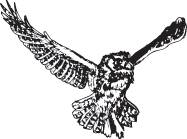

Glossary of terms - 'Bird Words'
Asynchronous hatching: The parents start incubating the eggs as soon as the first egg is laid. This produces a staggered hatching of several days between the first and last chicks. If the food is in short supply, the youngest - and therefore smallest - chicks will die, but some of the clutch will survive.
Blue List: A yearly list of bird species by the National Audubon Society of those species believed to be declining in numbers.
Cache: The storage of food items for later retrieval and use.
Camouflage: the colors and patterns animals have that help them blend in with their habitat. Camouflage helps prey hide from predators and it allows predators to sneak up on their prey without being seen.
Carrion: Prey animals found dead.
Clutch: The number of eggs laid by a female during nesting.
Conifers: Trees that are evergreen and have cones: pines, spruces, junipers and firs.
Convergent evolution: The development of similar features in unrelated species when they live in similar environments. Example: the talons and hooked bill of owls and hawks.
Crepuscular: Active during the dawn and dusk hours, as opposed to strictly nocturnal or diurnal.
Crop: The expandable pouch in the esophagus of some birds. It is a temporary food storage that allows its owner to eat very rapidly. Hawks and eagles have crops.
Diurnal: When animals are active during the day.
Ectoparasite: Parasites on the outside of the body such as lice.
Extinction: When a kind of plant or animal has all died. This is a natural process that is happening very, very rapidly today because of changes humans have made in the environment.
Facial disk: A saucer-shaped disk of movable feathers around the eyes of owls that direct light to its eyes and sound to its ears.
Imprint: The normal attachment of a young bird to its parents. This usually occurs during a very short time period after the chick opens its eyes and is able to focus. Now the chick knows what species it is, who to trust and who to mate with when it gets older.
Incubation: When birds sit on eggs and hatch them by the warmth of their body.
Kettle: A term used to describe a group of hawks flying in circles in thermals or updrafts.
Mantle: To spread its wings and tail over the food to hide it while eating.
Molt: The yearly process during which raptors lose their old feathers and replace them with new ones. Molting in small and medium-sized raptors takes several months. Larger birds such as vultures and eagles may take several years to replace their entire set of feathers.
Morph: Differences in plumage as a result of genetically controlled color phases (morphs) in individuals of a species. These differences are not related to age or season of the year.
Nocturnal: When animals are active at night.
Nomadic: The movement in which a population shifts from site to site between seasons in a relatively unpredictable manner. Short-eared owls migrate to sites where rodent populations are high.
Opportunists: With birds of prey it means that they will hunt what ever prey comes along. They do not wait for just one type of prey.
Pellet: Also called a casting. The regurgitated (spit-up) remains of undigested fur, feathers and bones that are produced by raptors after a meal.
Pesticide: A chemical poison (such as now-outlawed DDT) that is used to kill insect pests. Usually these chemicals get into food chains/food webs and kill other animals.
Scavenger: A carnivore that feeds upon animals that are already dead.
Symbiosis: A permanent relationship between two different species. The relationship in which both of the species benefits is called mutualism. Ravens finding a dead animal can't open up the carcass so they call wolves to open it and feed, the ravens feed later.
Symmetrical: Regularly shaped or able to be divided into similar parts.
Synchronous hatching: Incubation doesn't start until all the eggs are laid. All the eggs will hatch at the same time, some cases within an hour of each other. An available food supply is not a problem to these species.
Territory: The area in which bird lives and defends. A bird's song is one of the ways it stakes out and defends its territory.
Thermal: The rising body of warm air. Some soaring birds use this elevator to gain height without flapping their wings.
Third eyelid: An "extra" eyelid that birds use to cover and protect their eyes when capturing prey or diving very fast.
Tundra: A habitat in Northern Canada and Northern Alaska that is covered with low-lying vegetation like mosses, lichens, grasses and small shrubs.